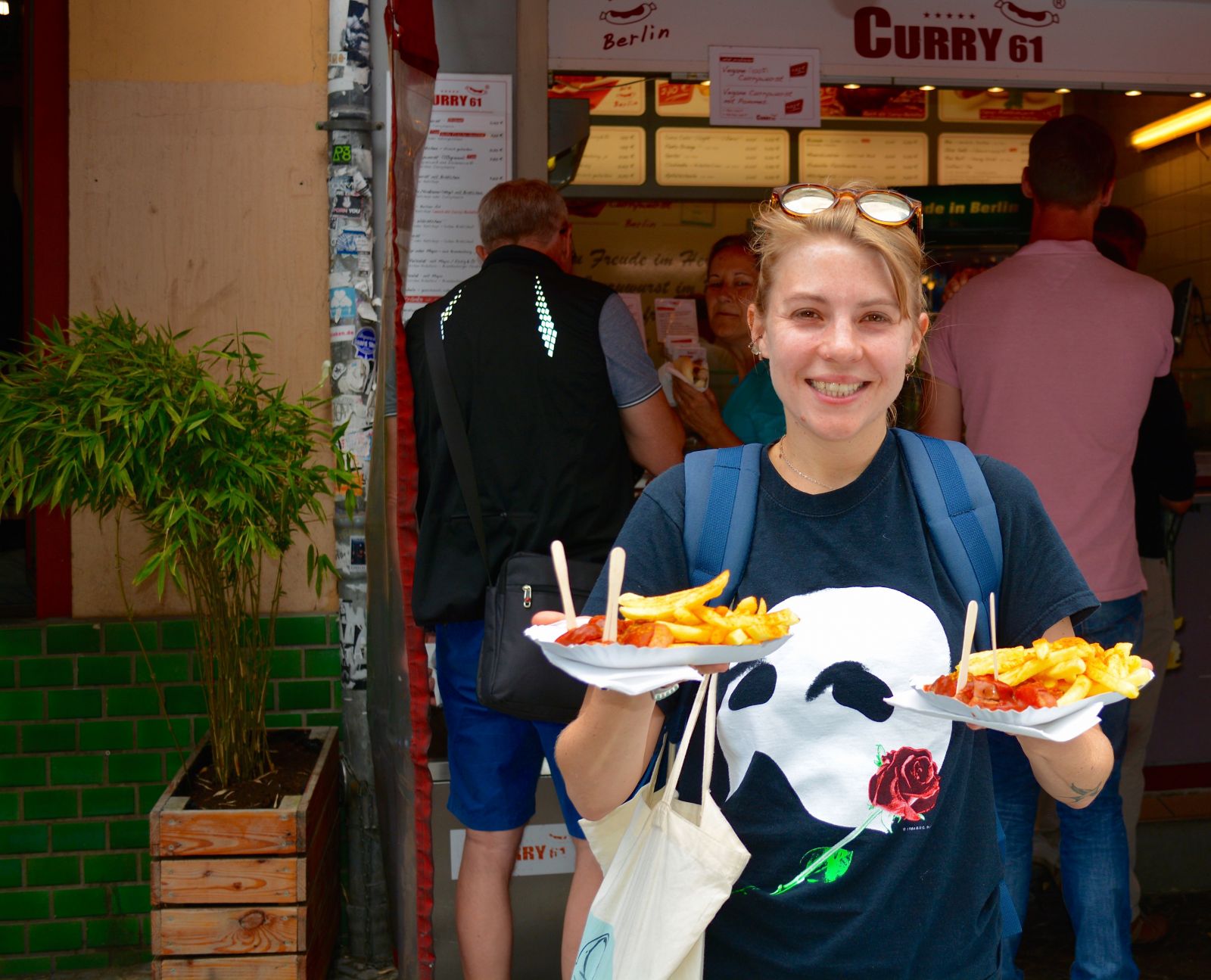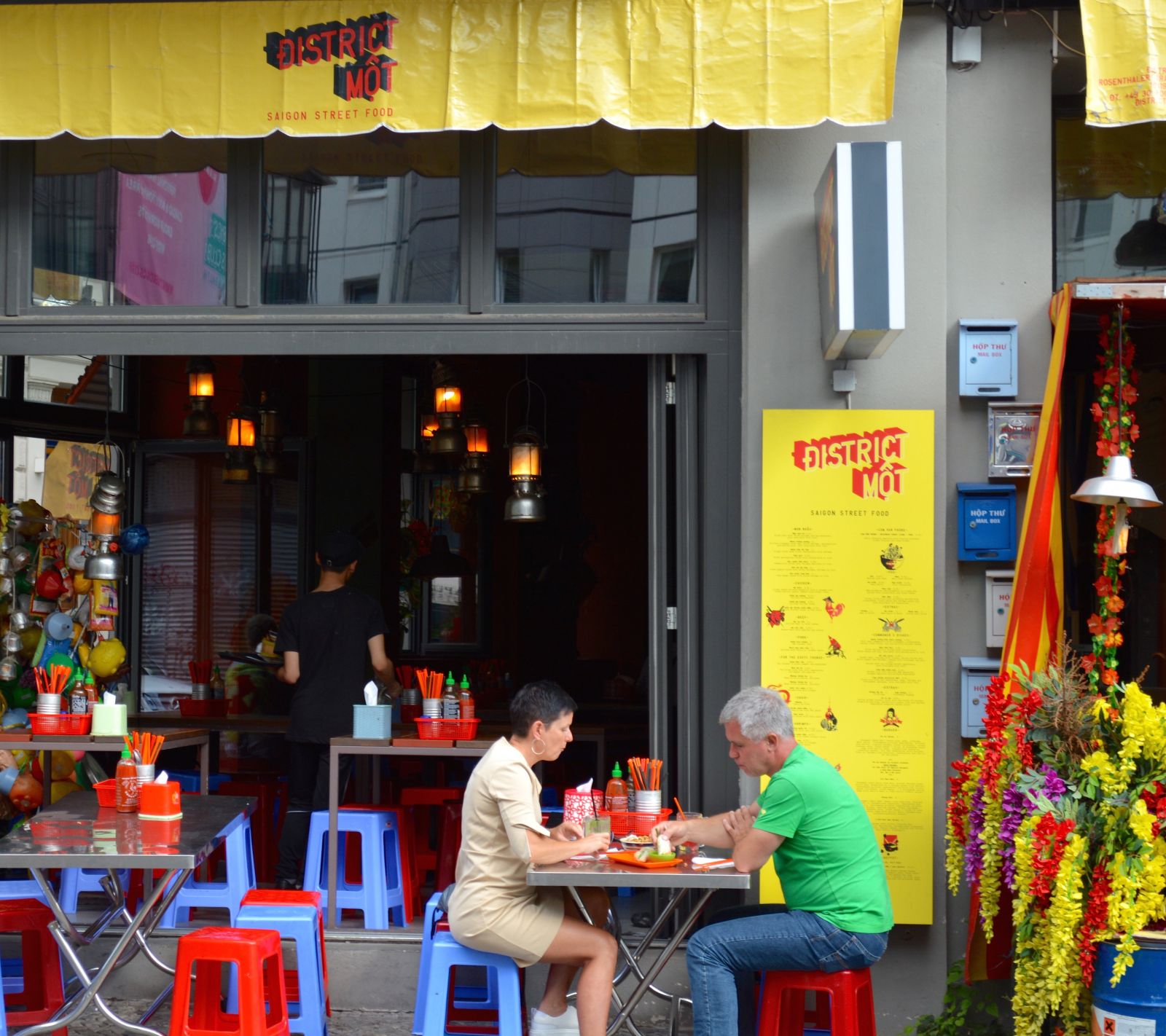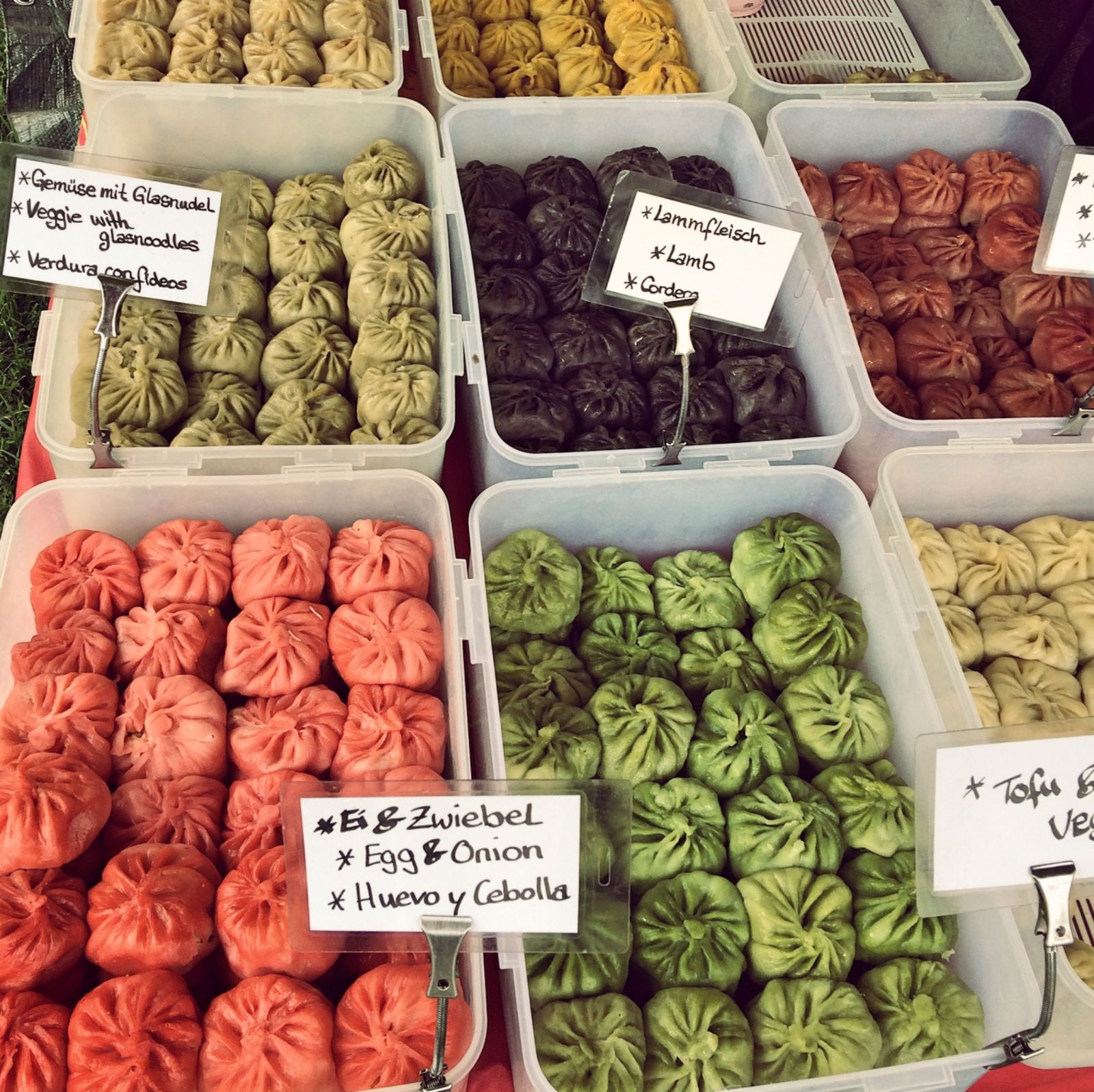If there’s a silver lining in any misery, Berlin’s street food is a gleaming example. One of the city’s blessings since the end of the Second World War is the flavors that arrived from afar and steadfastly seeped into its culture.
Decimated from bombings and warfare and then ripped into two by politics, the city found itself seeking a foundation. It turned to other nations to assist. Workers came from Turkey, divided Vietnam, Thailand, and elsewhere. Seventy years later, Berlin’s food scene is an authentic mix of ethnic cuisines that might surprise visitors who think all of Germany is predominantly Bavarian in flavor.
During her exceptional food tours, Samantha Reidie leads guests to some of the places where you can taste 21st-century Berlin.

Bite Berlin’s Samantha Reidie carries currywurst from Curry 61 to her clients. Currywurst is the most popular food in the city. (Adrian Brijbassi photo for VacayNetwork.com)
These bites will include a stop at District Mot, a Vietnamese eatery that has won a best burger competition in the city for five years in a row. That “burger” is a wheat rice bao bun stuffed with a beef patty that’s topped with a savory caramelized fish sauce. It is served with pickled vegetables, coriander, and soy bean skin. The burger, which costs 6 euros (about $7.20 USD), is part of the restaurant’s menu focused on “Saigon Street Food” and is emblematic of the impact immigrants have made on Berlin’s food scene.
“The Vietnamese came to both the west and east side of Berlin, so you will find incredible pho restaurants throughout the city,” notes Reidie, whose tour company is called Bite Berlin.

District Mot is one of Berlin’s many Vietnamese restaurants, which began to spread through the city in the 1960s. The colorful eatery serves “the best burger in Berlin.” (Adrian Brijbassi photo for VacayNetwork.com)
And she’s right. One of the first curiosities of Berlin you will notice is the proliferation of Asian restaurants. The North Vietnamese moved to the former East Berlin because of their government’s association with the Soviet Union, while the South Vietnamese arrived in the west. On either side of the Berlin Wall, both groups worked alongside other immigrants to help Germans rebuild the city.
Their culinary influence suits Berlin, which has some of the best inexpensive food choices in Europe.
The destination that should be at the top of any foodie’s list of places to nosh is Thai Park, which is the local nickname for Preussen Park in the city’s west side. On weekends, Thai Park fills with tents and home cooks toiling beneath them. Think of an Asian night market that takes place during the day and with patrons who are primarily European and you might imagine both the atmosphere and the quirky charm of the spot.
Want Real Asian Taste? Head to Berlin
For about 10 euros ($13 USD) you can enjoy a plate of Pad Thai prepared in a skillet before your eyes, and gyoza made from generations-old recipes, and fried coconut prawns, and a half-litre bottle of German pilsener. Better value you’ll never find.

District Mot’s bao burger is loaded with flavors from the Far East. (Adrian Brijbassi photo for VacayNetwork.com)
Thai Park is like much of Berlin. It’s unadorned, unsophisticated, unpretentious. It’s a land of WYSIWYG, and that’s utterly okay.
If you do want fancy, you can head to Kaufhaus des Westens, the largest department store in continental Europe. Its sixth floor is full of gourmet food stations, including restaurants where you can find German favorites like Wiener schnitzel, cabbage rolls, and savory strudels.
KaDeWe, as the mall is nicknamed, is celebrating its 110th year in 2017. It is worth a visit if only for the history. During the Cold War, KaDeWe was a symbol of West Germany’s prosperity, one of the places where the residents of the east coveted to go.

Dumplings abound in Thai Park, where they are fried for you as you wait — with your mouth watering, no doubt. (Adrian Brijbassi photo for VacayNetwork.com)
But it is on the streets where you’ll get to know Berlin’s contemporary tastes and culture. The journey will include currywurst, which arrived in the world by serendipity. A woman in East Berlin bartered with British military officers stationed at checkpoints along the Berlin Wall, giving them alcohol in exchange for any food better than the rations doled out to East Germans. The British provided her with ketchup and curry powder.
Not knowing what to do with the ingredients that were foreign to her, she combined them in a pot and poured them over two items with which she was familiar — sausage and bread. Years later, currywurst — slices of sausage smothered with ketchup and curry sauce, and served with bread or French fries — is the most popular food in Berlin. More than 17 million orders of it are consumed in a year. There are street food stalls serving it outside most train stations and at major corners in neighborhoods throughout the city.

Berliners gather each weekend at Thai Park, which is filled with home cooks making authentic Asian food beneath tents and umbrellas. (Adrian Brijbassi photo for VacayNetwork.com)
While North Americans can find artisanal versions of currywurst in restaurants like WVRST in Toronto or Bestie in Vancouver, the Berlin kind is — as you might suspect — not fancy or ambitious. It aims to give you sustenance with flavor, not a gourmet experience. Just like the city’s other street-food invention: the Doner (or Donair). The kebab filled with lettuce, onions, and tomatoes, and covered in a thick cream sauce was invented in the 1960s by a Turkish construction worker in West Berlin. Today, there are more than 1,000 doner shops in the city.
Doner is wrapped in flat bread. And that’s the other delight in Berlin.

Pad thai, anyone? You’ll have a difficult time finding any better than this dish in Berlin’s Thai Park. (Adrian Brijbassi photo for VacayNetwork.com)
Germany has more than 3,000 varieties of bread. Meals in the country are named after bread, as Reidie points out. Breads, of course, can also mean pastries. One of Berlin’s great exports is the cinnamon bun, called the cinnamon snail in Deutschland. At Zeit für Brot, you’ll find delicious versions that are flavorful and not sugary sweet.
How do you wash all of this down? Beer is the first option for many, but Germany also has outstanding white wines, and Reidie, who has an affinity for history as well as food, singles out one of the few surviving brands from East Berlin. The Champagne-style Rotkäppchen sparkling wine (whose name means “Little Red Riding Hood”) is much beloved in the city. In East Berlin, it was the only wine available to most people and remained popular after reunification in 1990. In 2002, the former East Berlin company that manufactured it famously bought out its counterpart in the west. Rotkäppchen, like so many other tastes you’ll discover in Berlin, has a story behind it and somehow that background makes it all the more satisfying to savor.
MORE ABOUT VISITING BERLIN

Pretzels remain one of Germany’s staple foods. Visitors will have plenty of chances to enjoy them while in Berlin. (Adrian Brijbassi photo for VacayNetwork.com)
Getting Around: Berlin has an immense public transit system that covers seemingly every corner of the city. Buses and trains that run both above ground (S-Bahn) and below ground (U-Bahn) are frequent and efficient. The fares are multi-tiered, depending on how far you travel and for how long. As there are no turnstiles and few transit officers checking tickets, the city’s trains are operated largely on an honor system. Visit the public transit website for details on planning your trip.
Where to Stay: The Sir Savigny Hotel is a delight. It is one of those trendy tech-savvy European hotels that takes a relaxed approach to guest relations. You are welcomed by a staff member who is free to roam around with a laptop so he or she can sit with you at a free space in the lounge to coordinate your check-in. Have a glass of water or order a drink through the process. Rooms are immaculate with an antique theme for its decor, and large, comfortable beds. Contemporary music plays in the lobby, elevator, and hallways (until about 9 p.m.). The on-site Butcher restaurant serves outstanding burgers and a fantastic breakfast featuring a buffet of breads, pastries, fruit, and cereals, and other options from the restaurant menu. Room Rates: Nightly weekend stays start at about 110 euro (about $133 USD), depending on the season.
What to Do: The highly recommended Bite Berlin tour costs 40 euro ($47.80 USD) per person and lasts about three hours, with five food tastings and a glass of sparkling wine to finish. It starts at Hackescher Market in the city’s east end. Thai Park (see map below) runs from noon til about 6 p.m. on Saturdays and Sundays when the weather is pleasant. Show up with blankets or folding chairs and prepare to enjoy the afternoon picnicking on the grass while enjoying vast amounts of Asian food made by home cooks.




